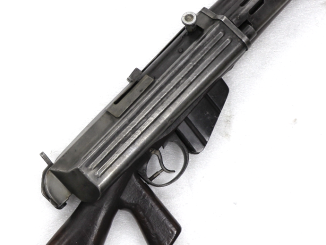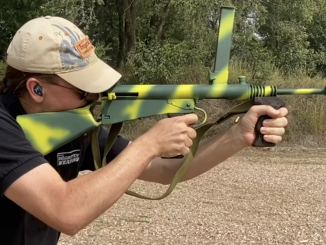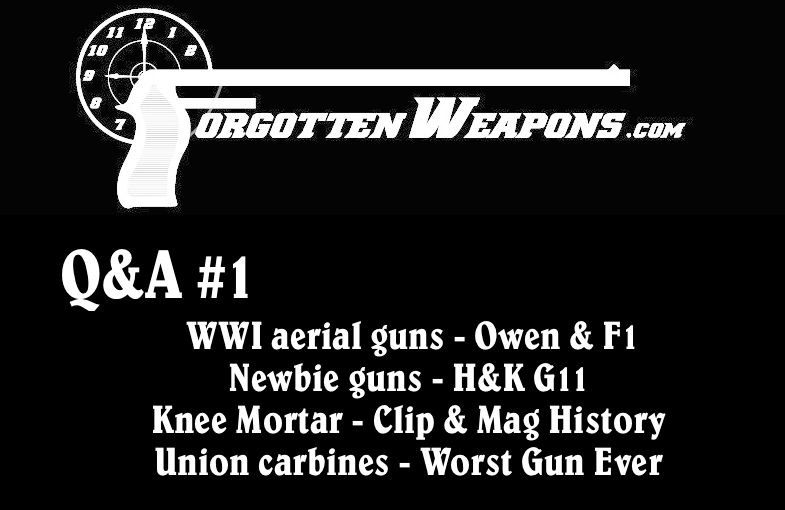This is Lot 2012 in the upcoming October Morphy Extraordinary auction.
The Owen Gun is one of the really good submachine guns fielded during the Second World War, but is a very scarce gun to find today. I had a chance to briefly shoot one year ago, and when I had the opportunity to try one out at Morphy’s, I jumped at it. Feeding from the top and ejecting out the bottom, and using a unique internal design that keeps the mainspring segregated from dirt and debris, the Owen was a famously reliable gun. It may look like a lot of rubbish, but it handles well and shoots well!




You are right : it would be a shame to wear out the spring by keeping the magazine loaded !
Finishes witha thumb up….Mick Dundee approves
An ugly, cheap and cheerful gun but beautiful performer – what the STEN aspired to but never (despite a clutch of virtues) quite reached. It surprising that it was not more widely used / picked up by other than the Australians – given that all who used it sang its praises.
It would be interesting to compare the Owen and, say, the MP5 or the grease gun in prone shooting — with a brush obstacle course included.
“Oh what a fallacy it is to equate beauty with goodness, and evil with ugliness.”
Nearly off-topic scenario:
Given a choice and plenty of proper ammunition, which would be the best pick for a nighttime jungle brawl?
1. Owen
2. MP5
3. M3A1
4. Hatsan Escort Raider
5. Mossberg 500
6. Remington Model 10 Trench Gun with bayonet
7. M16 with M203 grenade launcher
8. AG-043
9. FN Minimi
10. PKM
11. Or, per the usual, screw the budget and add your favorite toys to this list!
Then again, it’s way off topic. Just don’t throw literal flak at me.
In the dark, in close terrain, it’s pretty hard to beat a pump-action shotgun. Just Dutch-load it with single-O buck and slugs.
For a preference, pick one that (1) has no disconnector, so every time you pump it with the trigger held back it fires (Winchester M1897, M12, Ithaca M37, etc.), and (2) having a bayonet lug with something like an M1917 Enfield bayonet on the business end.
The latter is very effective for weapon retention, VCQB, and of course brush removal.
cheers
eon
“(…)11. Or, per the usual, screw the budget and add your favorite toys to this list!(…)”
Then grab Cristobal Model 2
https://modernfirearms.net/en/assault-rifles/dominican-republic-assault-rifles/cristobal-m2-eng/
.30 Carbine cartridge, so you get some penetration advantage over normal automatic pistol cartridges, yet much lighter than bigger intermediate cartridges. Designed for and used by Dominican Republic which is tropical maritime, so I presume it was tested and worked well in these environment. Furnished with long banana magazine from very beginning, (long magazine was also available for M2 Carbine, however some reliability problems of that gun were attributed to it).
Yeah, Winchester 1897 with M1917 bayonet is the way to go. Have one and the thing is incredible intimidating. Especially with the bayonet sticking of the end.
Also, unlike an SMG, you can “top off” the magazine of a pump shotgun by just shoving rounds in the loading port while keeping a live round in the chamber in event somebody tries to interrupt you while you’re reloading.
And consider that eight No. 0 buck in a 12-gauge shell is equivalent to eight .38 caliber or 9mm bullets with every trigger pull. Since muzzle velocity is around 1,400 F/S, the results at the receiving end are about the same, as well.
As for SMGs generally, I’ve yet to see anything one could do that an M1 or M2 carbine couldn’t do better. While weighing less, being more accurate, and hitting harder at all practical ranges.
cheers
eon
Magazine fed shotgun would win in any case.
From the Cherndog-provided list? I’d opt for either the 9mm Owen gun, or the Remington Model 10 with bayonet, loaded with 00 9-pellet buckshot shells, 2-3/4″.
The keys here that make the shotgun viable are a) dense jungle, and b) nighttime. If either of those two, or even both were absent, then any of the other rifled weapons would be preferable.
As for the Cristóbal in .30 carbine, Pal Kiraly, the Hungarian arms designer, left Szálaszi’s and later Soviet-occupied Hungary for Trujillo’s megalomaniacal and bizarre Dominican Republic. When, after March 1958, the U.S. subjected Fulgencio Batista’s regime to an arms cut-off, the dictator turned to Great Britain and Trujillo in the DR for weapons. Thus, the Cristóbal was used in Cuba by the “casquitos” of the armed forces, and by the M-26-7, DR, and other armed movements. These continued to be handed out to the CDRs and PNR well into the revolutionary state’s consolidation of power.
Thanks for the answers, Dave! Would you like me to provide a Stoner 63 as well?
From the Record of Developmental and Experimental Ordnance Vol. 17, The Sub-Machine Gun (Wash. D.C.: Office of the Chief of Ordnance, Research and Development Service, n.d.), IF23:
“OWEN–Designed by Lieutenant Evelyn Owen of the Australian Army, this gun (fig. 22) is manufactured in Australia and is standard equipment for the forces of that commonwealth. It weights 10.04 pounds, operates on the straight blowback principle, and fires the standard 9 mm British Parabellum cartridge from a 33-round magazine. The magazine feeds from the top and the sights are offset to the right to avoid interference by the rectangular magazine housing.
Fired cases are ejected from below, a decidedly unusual feature being that the ejector is an integral part of the magazine.
Cooling fins are machined on the barrel and the gun is fitted with a compensator [e.g. and early type] Semi-automatic and full-automatic fire are controlled by a change lever on the left side just above the trigger. When moved to the “Safe” position the change lever blocks the trigger.
The Owen was tested at Aberdeen Proving Ground on 104 May 1943 and was rated “good” in accuracy and “excellent” in general functioning, in functioning under the adverse conditions of dust and mud, and in general endurance. One round in 30 fired from a dusted magazine failed to feed due to the magazine follower sticking. There were no malfunctions after the standard mud test.
Two hundred rounds–40 of them in full-automatic fire–were fired after the gun had been thoroughly sprayed to simulate heavy rain. The weapon functioned perfectly.
ACCURACY–100 yards, machine rest, ten shots on each of three targets at semi-automatic fire, ten shots on three targets at full-automatic fire.
Semi-automatic: …. 6.22″ EHD 7.93″ EVD 8.65″ ES
Full-automatic: …. 7.20″ EHD 7.64″ EVD 10.28″ ES
Offhand position, semi-automatic fire, average of 100 shots
15.16″ EHD 16.2″ EVD 19.26″ ES
In full-automatic fire, offhand, at 50 yards, the Owen scored 89 hits out of 100 rounds fired on the standard 6’x6′ target. All accuracy tests in the off-hand position were fired by several gunners of various degrees of skill. Recoil was light and there was little tendency for the weapon to climb.
The fact that 9 mm ammunition was used throughout the test must be considered in any comparison of the Owen with the caliber .45 weapons.”
Not just used in WW2. Owens were used in Malaya by British, Australian and New Zealand forces during the insurgency and later during the Confrontation with Indonesia. Australian troops also carried Owens in Vietnam for the first couple of years before they were replaced with M16s. https://www.awm.gov.au/collection/C310912
The Owen was the favourite weapon of Colonel Suharto – later a General and the second President of the Republic of Indonesia – during the Indonesian struggle for independence from the Dutch. Presumably it had been captured from the Dutch forces that were trying to reconquer Indonesia post-WW2.